Features
Progress in Research Webinar Series, New and Renewed Multiproject Centers
The spring Progress in Research Webinar Series showcased 11 new and renewed multiproject centers funded by SRP in 2022. This feature highlights the recently funded centers and their interdisciplinary research to address complex environmental public health concerns for affected communities.
Emergencies and Emerging Contaminants
SRP-funded scientists develop advanced sampling techniques, use innovative modeling approaches, design sustainable cleanup strategies, and work closely with communities to promote health and resilience in the face of emergencies, such as extreme weather events. They also study hazardous substances that have been known to be harmful for decades, as well as those that are steadily gaining attention for their widespread occurrence and potential effects on human health.
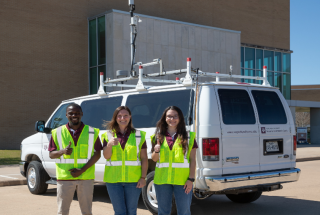
Led by Ivan Rusyn, Ph.D., the Texas A&M University SRP Center works to understand how disasters increase the health risks associated with contamination events. They take into consideration the vulnerabilities of communities affected by environmental contamination, and work closely with them to identify strategies to reduce hazardous exposures. Center scientists develop, apply, and translate a comprehensive set of tools and models to help first responders, communities, and government agencies characterize and mitigate the human health consequences of exposure to hazardous mixtures, particularly during environmental disasters.
For example, Natalie Johnson, Ph.D., and team are developing tools to rapidly characterize pediatric respiratory health risks from exposure to complex mixtures of air pollutants during disasters. Their mobile air quality monitors can quickly collect data on air pollutants in real time and identify hot spots of potential concern. The researchers deployed recently to assist with collecting air measurements in response to the train derailment in East Palestine, Ohio, and an industrial fire in Richmond, Indiana. In addition to measuring levels of harmful pollutants, the team was proactive in putting those results into context to share with community members.
Community Engagement Core investigator Garett Sansom, Ph.D., works closely with communities affected by environmental disasters to develop interventions to reduce exposure to harmful substances during emergencies while identifying opportunities to proactively plan for and manage future exposure risks. For example, in the aftermath of a large flash flood in the San Marcos area of Texas, the team created a community-led project to address community concerns. Three years later, the TAMU SRP Center team continue to be involved, such as through outreach activities with middle schoolers.
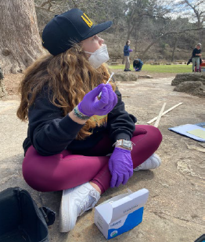
Led by Norbert Kaminski, Ph.D., the Michigan State University SRP Center investigates how dioxins, furans, biphenyls, and polycyclic aromatic hydrocarbons - which are commonly found at Superfund sites and pose a human health risk - affect the aryl hydrocarbon receptor (AhR). The AhR plays an important role in gene expression, immune response, and cellular processes. Center researchers aim to define how the environment, microbes, and animals respond to these environmental contaminants, while understanding how they move and change in the environment and developing advanced technologies to clean them up and reduce their toxicity.

For example, Brian Johnson, Ph.D., focuses on understanding how these chemicals disrupt thyroid function by combining computational models with high-throughput screening that combines human liver cells with thyroid cells. This approach better captures the complexity of interactions between different cell types and their responses to chemical mixtures while predicting population-level effects and who may be the most susceptible.
Brian Teppen, Ph.D., aims to decrease the toxicity of these contaminants by reducing their bioavailability. Bioavailability refers to the amount of a chemical that can be absorbed into the body where it can potentially cause harm. Using activated carbon materials that can strongly bind to contaminants and reduce their bioavailability, the team is helping to reduce exposures and toxicity while also offering cost savings to those responsible for cleaning up contaminated sites.
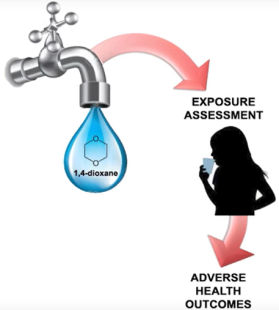
The Yale University SRP Center is driven by community-based concerns about emerging contaminants that affect water resources and drinking water supplies at multiple sites across the U.S. Led by Vasilis Vasiliou, Ph.D., center researchers engage in problem-based, solution-oriented research related to 1,4-dioxane, a contaminant that is widespread and persistent in the environment, poorly regulated, has consistently shown carcinogenic effects, and is not mitigated using standard approaches. The center addresses critical gaps in understanding cancer mechanisms, chemical mixture interactions, and detection and treatment technologies through innovative techniques that inform risk assessment and help affected communities remove these contaminants from their water supplies.
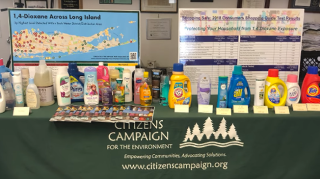
For example, Ying Chen, Ph.D., and team are working to understand the underlying mechanisms by which 1,4-dioxane can cause liver cancer and how co-occurring contaminants can worsen its effects. By combining studies in rodents with studies in liver cells and zebrafish, collaborators are tackling the problem from many angles while using high-throughput data, bioinformatics, and computational modeling to identify key molecular changes involved in 1,4-dioxane toxicity.
Jaehong Kim, Ph.D., is leading a team to develop small point-of-use water treatment technologies that destroy 1,4-dioxane and other frequently co-occurring contaminants using a process called advanced oxidation. Unlike traditional approaches that require using other chemicals, this strategy uses electricity as the energy source to kickstart the desired chemical reaction. The researchers are developing and testing their approach to confirm suitability, effectiveness, and decreased harmful byproducts compared to existing approaches. Their goal is to reduce human exposure to these harmful pollutants to protect health.
Heavy Metals in Native American Communities
The Progress in Research webinars featured two centers that focus on reducing exposures to heavy metals among communities in the U.S. Northern Plains. The University of New Mexico (UNM) SRP Center continues to study how exposures to toxic metals from mining waste affect health in the Southwest, where more than 600,000 Native Americans are estimated to live within about six miles of an abandoned mining site. Led by center director Johnnye Lewis, Ph.D., UNM SRP researchers collaborate with Indigenous partners from Navajo Nation and Laguna Pueblo to understand how environmental, biological, and cultural factors affect exposures, toxicity, policy, and interventions.

Alicia Bolt, Ph.D., is leading one project to understand how inhalation of particles containing metal mixtures might contribute to immune system dysfunction and autoimmunity. Through mechanistic research, they are evaluating the role of circulating immune cells called neutrophils as drivers of autoimmunity in those exposed to particulate metal pollution, as well as assessing associations between inflammation of the airways and proximity to legacy mine sites.
In another project, led by deputy director Jose Cerrato, Ph.D., researchers are evaluating biologically based remediation efforts to clean up legacy mine sites using plants and associated fungi. Specifically, they are trying to understand the biological mechanisms that govern how certain plant-fungal systems can remove toxic metals from soil and concentrate them in plant roots.

The newly funded Columbia University SRP Center is investigating the health effects, geochemistry, and remediation of arsenic and uranium among Tribal communities in the U.S. Northern Plains. Led by director Ana Navas-Acien, the center collaborates with Missouri Breaks Industries Research, Inc., a small Indian-owned business located on the Cheyenne River Sioux Reservation in South Dakota, on research and outreach projects. Together, they aim to lay the groundwork for effective interventions to reduce groundwater contamination by abandoned mines in Tribal areas.
For example, one project, led by Navas-Acien, is examining the cardiometabolic effects of past and current arsenic and uranium exposure using data from the Strong Heart As/U Lifelong study - the longest and largest epidemiological study of Native American cardiovascular health - and comparing results with mouse studies. The team hopes to uncover molecular mechanisms underlying metal-induced health effects, identify susceptible populations, and inform risk assessments for Northern Plains populations.
Meanwhile, Benjamin Bostick, Ph.D., is heading a project to address shortcomings in water remediation that often lead to incomplete removal of metal contamination in groundwater. Their goal is to develop sustainable water remediation technologies that harness bacteria capable of transforming hazardous metals into less toxic forms. Ultimately, the researchers want to commercialize their research designs for widespread use.
Protecting Communities from Drinking Water Contaminants
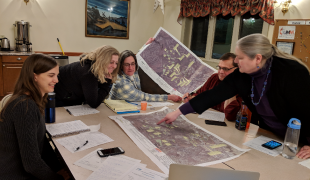
Contaminants of emerging concern enter our environment every day. To address the needs of affected communities, SRP centers work to understand where these chemicals come from, how they move through and transform in the environment, what their potential health effects are, and what strategies can be implemented to clean up contaminated sites and protect human health.
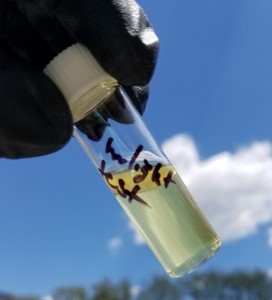
Led by center director Bevin Engelward, Sc.D., the Massachusetts Institute of Technology (MIT) SRP Center studies N-nitrosodimethylamine (NDMA), a carcinogenic chemical found in Wilmington, Massachusetts groundwater. Due to concerns about links between NDMA exposure and childhood cancer, the site was designated a Superfund priority in 2006.
To understand the mechanisms behind NDMA's link to cancer, John Essigmann, Ph.D., leads one project assessing DNA damage following NDMA exposure. The team discovered that the chemical causes a unique mutational pattern, which is identifiable across multiple different organs. According to the researchers, examining tumor cells to identify patterns of DNA damage could help determine what led to the development of that tumor in the first place.
Another project, led by Timothy Swager, Ph.D., seeks to develop quick and cost-effective methods to detect NDMA in water. Because NDMA breaks down in the presence of light, the team created a technique using special molecules that change color as NDMA fragments form. This method can be easily used by community members to determine if NDMA is present in their water, the researchers said.
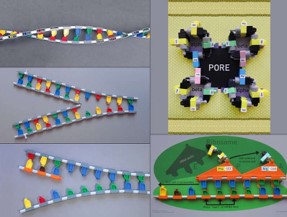
Desiree Plata, Ph.D., heads a project focused on developing novel treatment technologies to remove NDMA from water, such as electrochemistry, which is capable of degrading compounds that are otherwise difficult to break down. The team is also building mailer kits so communities that are further away, like Tribes, can send in water samples for laboratory analysis. To maintain a bi-directional relationship with Tribal communities, MIT's Community Engagement Core, led by Kathleen Vandiver, Ph.D., works with Tribes in Maine to improve environmental health literacy and engage youth in science.
Led by director Martyn Smith, Ph.D., the University of California (UC), Berkeley SRP Center assesses the health risks from exposure to contaminants, such as arsenic, chromium, per- and polyfluoroalkyl substances (PFAS), and halogenated contaminants. According to Smith, Superfund sites commonly contain mixtures of chemicals that may interact with each other, forming harmful byproducts. The center's goal is to address complex problems associated with chemical mixtures at hazardous sites in order to protect affected communities from the health effects of exposures.
Rachel Morello-Frosch, Ph.D., is leading a community-engaged project to characterize chemical contaminants in tap water, assess their effects on birth outcomes, and facilitate public health action by reporting results back to participants. The team is conducting water sampling among households in primarily agricultural communities, with analysis to measure arsenic, nitrates, and PFAS, as well as a non-targeted assessment to detect unknown chemicals.
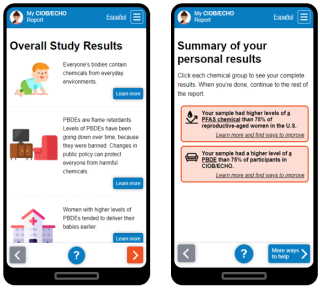
Upon finishing the drinking water analysis, Morello-Frosch and team plan to return water quality results to participants using the Digital Exposure Report-Back Interface (DERBI), originally developed by Silent Spring Institute with SRP support. The team plans to use DERBI's smartphone interface, depending on participants' preferences, as many community members rely on cell phones to access the internet.
To clean up hazardous sites and protect the health of communities, UC Berkeley's remediation projects seek to use on-site approaches to destroy Superfund contaminants. According to David Sedlak, Ph.D., many contaminants of emerging concern are extremely difficult to break down, sparking the need for new, innovative remediation methods.
Sedlak leads a project that takes advantage of the chemical properties of free radicals - unstable and highly reactive molecules - to destroy contaminants like PFAS and chlorinated solvents. The team plans to determine conditions that minimize the formation of toxic byproducts in order to develop remediation approaches that can be used in the field.
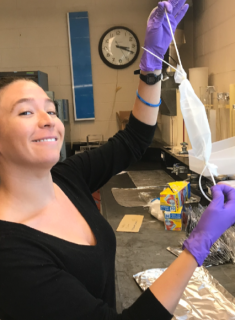
The University of Rhode Island (URI) SRP Center, led by director Rainer Lohmann, Ph.D., aims to understand the transport and transformation of PFAS in the environment. The URI SRP team also works to advance the understanding of PFAS toxicity in the human body and to prevent health effects, particularly in children. With the U.S. Environmental Protection Agency's recent proposal to regulate PFAS compounds, Lohmann expects to see increases in PFAS testing across the country.
Elsie Sunderland, Ph.D., heads one project to assess how chemical precursors that degrade into PFAS contribute to PFAS exposures near contaminated sites. Though most prior work has focused on drinking water as the main source of exposure, PFAS precursors have been detected in atmospheric samples as well as contaminated seafood. The team is developing models to understand PFAS bioaccumulation in fish, characterizing atmospheric PFAS emissions, and creating a screening tool to identify private wells with potential PFAS contamination.
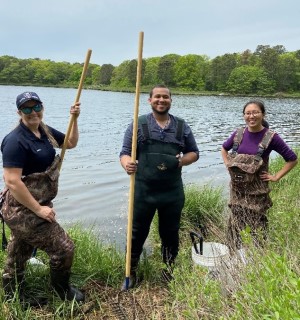
Another project, led by Phillippe Grandjean, Ph.D., seeks to understand the health effects of PFAS exposures in the Faroe Islands, where high rates of seafood consumption result in a wide range of PFAS exposures. The team is following cohorts of children to track health outcomes associated with blood PFAS levels. According to Grandjean, results to date show that higher PFAS exposures are associated with higher cholesterol and lower bone mass density.
Angela Slitt, Ph.D., is leading a project on the mechanisms of PFAS toxicity to uncover key molecular and cellular processes that contribute to PFAS distribution in the body. By understanding the mechanisms of PFAS exposure and toxicity, the team hopes to develop interventions to target those pathways and decrease the health effects of exposure to hazardous substances.
Chemical Exposures Across the Life Course
Chemical exposures impact health across the life course, from pre-term birth to the development of diseases much later in adulthood. SRP-funded researchers study how contamination from legacy industrial sites can affect human health at different life stages, and how to reduce those health risks.
Led by Heather Stapleton, Ph.D., the Duke University SRP Center seeks to reveal how to both polycyclic aromatic hydrocarbons (PAHs) and heavy metals before birth and during infancy can influence the development of diseases later in life. PAHs and metals are among the top 10 contaminants identified at Superfund sites and often co-occur, but the effects of exposure to mixtures of these contaminants are not well understood.
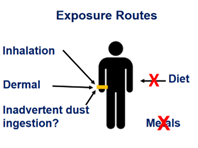
Stapleton and Kate Hoffman, Ph.D., study how exposure to PAHs and heavy metals in utero can affect children's neurodevelopment. The researchers are following a group of 1,000 pregnant women and their babies living in Durham, North Carolina. To assess environmental exposures, the women wear silicone wristbands for one week during each trimester of pregnancy. The wristbands are a non-invasive approach to monitor hundreds of organic chemicals, including PAHs. To understand neurodevelopmental effects, babies in the study wear a smart sock that records their heart rate and movement during sleep. Irregular heart rate and moving too much are markers of disordered sleeping, which is associated with hyperactivity, impaired attention, cognitive function, and behavior problems.
Another project, led by Nishad Jayasundara, Ph.D., aims to uncover the mechanisms by which aquatic organisms adapt to PAH exposure and how these adaptations may have consequences later in life. Jasayundara and team are conducting studies in a population of killifish from the Elizabeth River in Virginia, which is known to have PAH contamination, and comparing them to fish from an uncontaminated site. Building on earlier research that showed that changes in the gut microbiome play a role in adaptation to PAHs, the researchers are adding bacteria from the gut of PAH-resistant fish into the guts of fish that are not yet resistant to further uncover the microbiome's protective mechanisms.
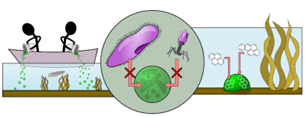
Claudia Gunsch, Ph.D., and Heileen Hsu-Kim, Ph.D., are developing an approach to remove PAHs from contaminated sites. Their strategy uses a variety of fungi and bacteria that can break down PAHs without creating toxic byproducts. The researchers are creating small capsules to contain the microorganisms and deliver them to contaminated soil and sediment. They are also conducting studies in contaminated sites in Virginia and North Carolina to determine which microorganisms are most effective at remediating the types of PAHs in each site and develop technologies that are site-specific.
The Wayne State University SRP Center was founded in response to the high preterm birth and maternal death rates in Detroit, Michigan. Led by Melissa Runge-Morris, M.D., the center aims to develop solutions to reduce exposure to volatile organic contaminants (VOCs), a common class of contaminants found in Detroit's subsurface and at Superfund sites that are linked to adverse birth outcomes, among other health risks.
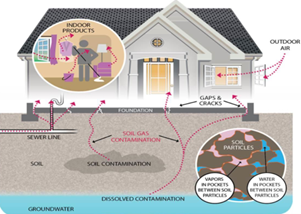
Center scientists are conducting mice studies to understand how VOC exposure increases inflammation of the placenta, and how this may lead to preterm birth and other outcomes in offspring. The placenta, an organ that develops in the uterus during pregnancy, supplies the fetus with oxygen and nutrients, removes harmful waste, and produces hormones that help with fetal growth. Led by Gil Moore, Ph.D., the team is testing the hypothesis that inflammation alters the development of the fetal immune system, making them more susceptible to infections in the mother's uterus and after birth. Preliminary research findings show that VOC exposure impacts the placenta of male and female offspring differently, suggesting that sex differences are a potential mechanism that requires more attention, say the researchers.
The extent of VOC exposure in Detroit and across the U.S. is not well known, and thousands of sites with potential contamination remain untested. Current technologies to detect and measure VOCs are costly and are not suitable for VOCs found underground. To address these challenges, researchers led by Glen Hood, Ph.D., are creating a strategy that uses plants to measure the contaminants. In short, the plants take up VOCs into their roots and transport them to aboveground plant tissues, which are then taken to the lab to measure the contaminants.

Hood is collaborating with the Community Engagement Core to use this approach to measure VOCs in the homes of pregnant women involved in another study at the center, which is following a group of pregnant women in Detroit to characterize VOC exposure and its link to preterm birth.
Meanwhile Tracy Baker, Ph.D., is conducting studies in zebrafish to reveal the mechanisms by which exposure to VOCs affects the development, immune function, and reproductive health of adults and their offspring. Baker and team are also examining the effects of VOC exposure on zebrafish behavior.
Led by Sanjay Srivastava, Ph.D., the University of Louisville SRP Center is examining how VOC exposure affects the prevalence and severity of cardiometabolic diseases, such as heart disease, obesity, and diabetes. Heart disease is the leading cause of death in the U.S. Center researchers have linked VOC exposure to harmful effects to the cardiovascular system, high blood pressure, and damage to the endothelium - a membrane that serves as protective barrier in the heart and blood vessels.

An interdisciplinary team of scientists at the center is establishing a study in Jefferson County, Kentucky, to reveal the link between VOC exposure and cardiometabolic diseases. The researchers recruited over 1,000 participants and will be sampling VOC exposure at the individual and community levels. They will compare those exposures to health records from in-person clinical exams looking at cardiometabolic diseases and population-level cardiometabolic disease-related mortality and hospital admissions.
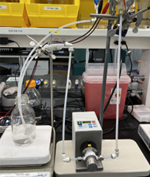
To detect and quantify VOCs, a team led by Michael Hantz, Ph.D., created a novel technology that uses gold-based gas sensors. The tool, which can collect data on hundreds of VOCs during 10-minute periods, has already been used to monitor outdoor and indoor air at several homes in the study. The team is now working on adapting their technology to create smaller sensors for monitoring VOCs at the individual level.
Another project, led by John Fortner, Ph.D., is creating a new technology to remove VOCs from the environment. The tool uses a unique class of nanomaterials that generate heat when they are in contact with electromagnetic radiation. In short, when the nanomaterials are subjected to radiation, such as microwaves in the lab or solar radiation in the field, they generate extreme, surface-localized heat that can destroy VOCs.
to Top



